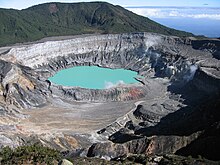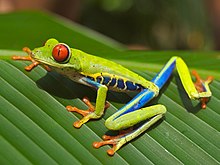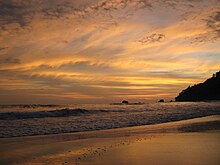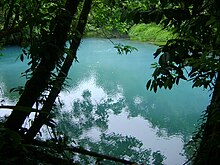
A | B | C | D | E | F | G | H | CH | I | J | K | L | M | N | O | P | Q | R | S | T | U | V | W | X | Y | Z | 0 | 1 | 2 | 3 | 4 | 5 | 6 | 7 | 8 | 9


Tourism in Costa Rica has been one of the fastest growing economic sectors of the country[2] and by 1995 became the largest foreign exchange earner.[3][4] Since 1999, tourism has earned more foreign exchange than bananas, pineapples and coffee exports combined.[5] The tourism boom began in 1987,[3] with the number of visitors up from 329,000 in 1988, through 1.03 million in 1999, over 2 million in 2008, to a historical record of 2.66 million foreign visitors in 2015.[6][7] In 2012, tourism contributed with 12.5% of the country's GDP and it was responsible for 11.7% of direct and indirect employment.[8] In 2009, tourism attracted 17% of foreign direct investment inflows, and 13% in average between 2000 and 2009.[9] In 2010, the tourism industry was responsible for 21.2% of foreign exchange generated by all exports.[10] According to a 2007 report by ECLAC, tourism contributed to a reduction in poverty of 3% in the country.[9]
Since the late 1980s, Costa Rica became a popular nature travel destination, and its main competitive advantage is its well-established system of national parks and protected areas,[11] covering around 23.4% of the country's land area,[12] the largest in the world as a percentage of the country's territory,[13][14] and home to a rich variety of flora and fauna, in a country that has only 0.03% of the world's landmass, but that is estimated to contain 5% of the world's biodiversity.[15][16] The country also has plenty of beaches, both in the Pacific Ocean and the Caribbean Sea, within short travel distances, and also several volcanoes that can be visited with safety. By the early 1990s, Costa Rica became known as the poster child of ecotourism,[16] with tourist arrivals reaching an average annual growth rate of 14% between 1986 and 1994.[3][17]
According to the Costa Rican Tourism Board, 47% of international tourists visiting the country in 2009 engaged in activities related to ecotourism, which includes trekking, flora, fauna, and bird watching, and visits to rural communities. However, most visitors look for adventure activities.[18]
Description and key statistics
Graphs are unavailable due to technical issues. There is more info on Phabricator and on MediaWiki.org. |
Costa Rica stands as the most visited nation in the Central American region, with 3.14 million foreign visitors in 2019. During the same year, El Salvador was ranked second in the region with 1.77 million, followed by Panama and Guatemala with 1.75 million visitors each.[19]
The number of tourists visiting Costa Rica surpassed the 2 million milestone in 2008, and tourist-related income reached US$2.1 billion that year.[20] As a result of the Great Recession, international arrivals began falling since August 2008, as the number of U.S. citizens visiting the country shrank, and this market segment represented 54% of all foreign tourists visiting Costa Rica.[21]
| Year | Arrivals (x1000) |
Year | Arrivals (x1000) |
Year | Arrivals (x1000) |
Receipts USD million |
Year | Arrivals (x1000) |
Receipts USD million |
|---|---|---|---|---|---|---|---|---|---|
| 1988 | 329 | 1996 | 781 | 2004 | 1,453 | 1,358 | 2012 | 2,343 | 2,313 |
| 1989 | 376 | 1997 | 811 | 2005 | 1,679 | 1,570 | 2013 | 2,428 | 2,665 |
| 1990 | 435 | 1998 | 943 | 2006 | 1,725 | 1,732 | 2014 | 2,527 | 2,864 |
| 1991 | 504 | 1999 | 1,032 | 2007 | 1,973 | 1,974 | 2015 | 2,660 | 2,882 |
| 1992 | 611 | 2000 | 1,088 | 2008 | 2,089 | 2,144 | 2016 | 2,925 | 3,716 |
| 1993 | 684 | 2001 | 1,131 | 2009 | 1,923 | 2,075 | 2017 | 2,960 | 3,876 |
| 1994 | 762 | 2002 | 1,113 | 2010 | 2,100 | 1,999 | 2018 | 3,017 | 3,773 |
| 1995 | 785 | 2003 | 1,239 | 2011 | 2,192 | 2,152 | 2019 | 3,139 | 4,010 |
The combined effect of the global economic crisis and the 2009 flu pandemic resulted in a reduction of tourists arrivals in 2009 to 1.9 million visitors, an 8% reduction as compared to 2008.[31] In 2010, the number of visitors rose to 2.1 million, barely exceeding the 2008 peak,[10] and a record was reached in 2012 with 2.34 million visitors, a 6.9% increase over 2011.[23]
A historical record of 2.5 million international visitors arrived in the country in 2014, up 4.1% year-on-year, and the corresponding receipts rose to US$2.636 billion in 2014, up 8.3% from the previous year.[22] In addition, the average expenditure per tourist increased from US$1,171 in 2010 to US$1,431 in 2014, and the average stay increased from 11 days in 2010 to 13.4 in 2014.[7] Costa Rica achieved new records in 2016 with 2.93 million visitors and total earnings of US$3.716 billion.[30] The country finally reached the 3 million tourists' milestone in 2018.
In terms of the 2017 Travel and Tourism Competitiveness Index (TTCI), Costa Rica reached the 38th place in the world ranking, classified as the fourth most competitive among Latin American countries after Mexico (22), Brazil (27) and Panama (35), and ranking sixth in the Americas.[32] Just considering the subindex measuring natural resources, Costa Rica ranks in the 3rd place at a worldwide level, 21st in the world when considering international openness criteria, and 24th worldwide when considering the subindex measuring prioritization of travel and tourism. The 2017 TTCI report also notes Costa Rica's main weaknesses are price competitiveness (108th) and ground and port infrastructure (99th), with quality of the roads ranking 123th and ground transport efficiency 108th between 138 countries analyzed.
In 2012, most visitors came from the United States (39.3%), Nicaragua (20.2%), Canada (6.5%), Panama (3.9%), and Mexico (2.9%).[33] Tourists from North America and European countries made up 60.8% of all international visitors, and visitors from Central America represented 30.8%.[33] According to a 2006 survey, visitors from the Caribbean Basin and South America travel to Costa Rica mainly for business or professional purposes, while a majority of Americans, Canadians and Europeans visit the country for leisure. Word of mouth from friends and family, with an average of 58%, was the leading reason for visiting Costa Rica for vacations and leisure. The main visitor's complaint is the poor condition of the roads.[5]
| Top 30 visitor arrivals by country of origin in 2018[34] | |||||||
|---|---|---|---|---|---|---|---|
| Ranking | Country of origin |
Visitor arrivals 2018 |
% Yearly growth |
Ranking | Country of origin |
Visitor arrivals 2018 |
% Yearly growth |
| 1 | 1,265,067 | 5.5 | 16 | 32,561 | 7.4 | ||
| 2 | 416,915 | -3.0 | 17 | 29,171 | 0.4 | ||
| 3 | 217,006 | 7.5 | 18 | 28,884 | 13.7 | ||
| 4 | 98,918 | -7.4 | 19 | 22,329 | 3.9 | ||
| 5 | 92,802 | -11.4 | 20 | 18,297 | 35.5 | ||
| 6 | 76,937 | -5.1 | 21 | 15,249 | 12.0 | ||
| 7 | 74,574 | 5.1 | 22 | 14,865 | 12.1 | ||
| 8 | 74,338 | -2.4 | 23 | 14,359 | -1.3 | ||
| 9 | 74,032 | 6.1 | 24 | 12,381 | 0.9 | ||
| 10 | 68,634 | -1.2 | 25 | 11,159 | -9.4 | ||
| 11 | 65,633 | -15.9 | 26 | 11,117 | 11.3 | ||
| 12 | 46,723 | -2.6 | 27 | 8,236 | 11.1 | ||
| 13 | 40,832 | 31.8 | 28 | 8,089 | 5.2 | ||
| 14 | 38,135 | -5.4 | 29 | 6,574 | 7.4 | ||
| 15 | 33,197 | -17.6 | 30 | 6,460 | 8.5 | ||
| Visitor arrivals by region of origin in 2018 (Top 4) | |||||||
| 1 | North America | 1,580,991 | 4.8 | 3 | Europe | 480,102 | 3.9 |
| 2 | Central America | 691,386 | -6.0 | 4 | South America | 190,413 | 5.0 |
Comparative performance in the Latin American market
The following table presents a comparison of Costa Rica's tourism industry performance with selected countries from the Caribbean Basin and South America, including Bahamas, Cuba, and several of the top ten Latin American countries according to their 2013 Travel and Tourism Competitiveness Index (TTCI), which are competitors in the nature travel market segment.
| Selected Caribbean and Latin American countries |
Internl. tourist arrivals 2012[29] (x1000) |
Internl. tourism receipts 2012[29] (million USD) |
Receipts per arrival 2012 (col 2)/(col 1) (USD) |
Arrivals per capita per 1000 pop. (estimated) 2007[20][35] |
Receipts per capita 2005[36] USD |
Revenues as % of exports goods and services[24] 2003 |
Tourism revenues as % GDP[8][24] 2012 |
% Direct & indirect employment in tourism[8][24] 2012 |
World Ranking Tourism Compet.[8] TTCI 2013 |
Index value TTCI[8] 2013 |
|---|---|---|---|---|---|---|---|---|---|---|
| 1,419 | 2,367 | 1,668 | 4,616 | 6,288 | 74.6 | 34.1 | 68.7 | n/d |
n/d | |
| 536 | 916 | 1,709 | 1,956 | 2,749 | 58.5 | 42.7 | 41.9 | 27 | 4.88 | |
| 5,677 | 6,645 | 1,170 | 26 | 18 | 3.2 | 8.9 | 8.1 | 51 | 4.37 | |
| 3,554 | 2,201 | 619 | 151 | 73 | 5.3 | 8.4 | 8.0 | 56 | 4.29 | |
| 2,175 | 2,351 | 1,081 | 26 | 25 | 6.6 | 5.1 | 5.5 | 84 | 3.90 | |
| 2,343 | 2,425 | 1,035 | 442 | 343 | 17.5 | 12.5 | 11.7 | 47 | 4.44 | |
| 2,688 | 2,283 | 849 | 188 | 169 | n/d | n/d | n/d | n/d | n/d | |
| 4,563 | 4,549 | 997 | 408 | 353 | 36.2 | 14.7 | 13.6 | 86 | 3.88 | |
| 1,986 | 2,043 | 1,029 | 628 | 530 | 49.2 | 25.7 | 23.8 | 67 | 4.08 | |
| 23,403 | 12,739 | 544 | 201 | 103 | 5.7 | 12.4 | 13.7 | 44 | 4.46 | |
| 1,606 | 2,259 | 1,406 | 330 | 211 | 10.6 | 10.1 | 9.6 | 37 | 4.54 | |
| 2,846 | 2,657 | 933 | 65 | 41 | 9.0 | 9.1 | 7.8 | 73 | 4.00 | |
| 2,695 | 2,076 | 770 | 525 | 145 | 14.2 | 10.2 | 9.7 | 59 | 4.23 |
- Notes: Green shadow denotes the country with the top indicator. Yellow shadow corresponds to Costa Rica's.
(1) Visitors and receipts for Cuba correspond to 2011. For Bahamas tourism revenues as % GDP are for 2003, and direct and indirect employment for 2005.
Ecotourism









Ecotourism is extremely popular with the many tourists visiting the extensive national parks and protected areas around the country. Costa Rica was a pioneer in this type of tourism and the country is recognized as one of the few with real ecotourism.[16] In 2006, 54% international tourists visited national parks or protected areas, visiting at least two such natural refuges, and it goes up to three for European visitors.[37]
In recent years, several of Costa Rica's top travel service providers have been internationally recognized for their commitment to planet-positive tourism. Examples include Nature Air[38] and Hotel Punta Islita[39] as winners of the Tourism for Tomorrow Awards, sponsored by the World Travel and Tourism Council (WTTC), and Lapa Rios Ecolodge[40] as winner of the Rainforest Alliance Sustainable Standard-Setter.
The "Bandera Azul" Program
Implemented in 1996 and inspired by a similar program developed in Europe in 1985,[41] the "Bandera Azul Ecológica" (Ecological Blue Flag) Program is intended to promote development while curbing the negative impacts of mass tourism by helping the local community to work against pollution and protecting the environment. The program evaluates the environmental quality of coastal areas, in terms of the quality of the beaches and sea water, access and quality of drinking water, water and waste management, security, and environmental education. Depending on the degree of compliance against the optimal criteria established, a certain number of stars are awarded to the Blue Flag.[42]
After the first evaluation, ten beaches were awarded the distinction, which usually is highly publicized to potential visitors.[43] In 2008, based on the evaluation carried out in 2007, 59 beaches kept the distinction while eight beaches lost it.[42][44] In 2009, out of 81 applicants, only 61 beaches won the distinction, and just two obtained the maximum 5 stars, Playa Blanca in Punta Leona and Playa Langosta in Santa Cruz.[45]
Voluntary Certification Program
Developed in 1997 by the Costa Rican Tourism Board, the public agency responsible for tourism development and regulation in the country, a voluntary Certification for Sustainable Tourism Program (known as CST) was introduced in order to turn "the concept of sustainability into something real" by "improving the way in which the natural and social resources are utilized, to motivate the active participation of the local communities, and to support the competitiveness of the business sector."[3] The program was aimed for all types of businesses in the tourism industry, but it began only with lodging providers. By 2007, a total of 108 parameters are considered for the CST evaluation.[46]
CST hopes to encourage businesses to become sustainable in a variety of ways, including using recycled products, implementing water and energy saving devices, properly disposing and treating waste, conserving and expanding Costa Rica's forests, and developing better systems of information management.[47] As of October 2009, out of approximately 3,000 hotels and tours operators,[48] only 105 have a Certification for Sustainable Tourism.[49] Some tour operators in the U.S. and Europe promote several small hotels that hold this certification through their travel packages.[50]
Educational Opportunities
Costa Rica is a beautiful country with lots of educational opportunities. One opportunity is to learn about the history of oxcarts. In 2005, Costa Rica’s oxcarts with beautiful colors and designs were recognized by UNESCO (United Nations Educational, Scientific and Cultural Organization) and declared them to be an Intangible World Heritage.[51] You can learn about these oxcarts and how they transformed from symbols of Spanish colonization to a treasured symbol featured in most holidays and celebrations.
Another educational opportunity is Museo Nacional de Costa Rica. This museum will enlighten you on the lifestyle of ancient cultures through artifacts and carvings recovered over time. Some of the artifacts show a glimpse of the rituals and celebrations that took place in Costa Rica hundreds of years ago.[52] In addition to the artifacts there is information about some of Costa Rica’s political history including involvement in Civil Wars and its well-known Presidents.
Ethical Traveler Destination
Costa Rica was listed by Ethicaltraver.org in "The Developing World's 10 Best Ethical Destinations" for 2011 and 2012. These lists were complied using metrics such as environmental protection, social welfare, and human rights.[53]
Costa Rica was absent from the list for several years because World Vision considered the country among the world's most notorious destinations for human trafficking and sexual predators. Ethical Traveler included Costa Rica on the 2011 list due to the government's efforts to address the problem.[54]
Camino de Costa Rica
The Camino de Costa Rica is a 280 km long hiking trail across Costa Rica. It runs from the Atlantic Ocean (Caribbean coast), the southernmost part of the Tortuguero Canals, up the mountain and through indigenous territory near the Barbilla National Park and through valleys and mountain ranges of the central region of the country, just south of the Turrialba and Irazu Volcanos and through the Los Santos coffee region down to the Pacific coast in Quepos. By 2018, the rural population had declined from 40% inhabitants (2000) to 27% inhabitants, poverty at 25% was significantly higher than among the urban population, and income was more than 40% lower. These sobering facts as well as other factors such as level of education, unemployment and underemployment in rural areas gave rise to the NGO, the Asociación Mar a Mar in year 2016. The aim of the Camino de Costa Rica is to establish a world class long-distance trail and through its success in bringing hikers from all over the world, to improve the economic situation in the rural areas of Costa Rica.
Beaches and adventure
Most of the main attractions are nature related, a combination of ecotourism with leisure and adventure activities: sun, sea and sand (55%); flora and wildlife watching (44%); visiting volcanoes (43%); trekking (41%); bird watching (30%); canopy tours (26%); bungee jumping from bridges (11%); surfing (11%); snorkeling (10%); and rafting (7%). Cultural activities such as visiting museums, art galleries and theaters corresponds to 11%, and business travel corresponds to 17%.[37]
Seven Costa Rican resorts were included in the 2012 Condé Nast Traveler Readers' Choice Awards, ranking among the top 15 resorts in Central and South America. The resorts are Xandari Resort and Spa (2), Four Seasons Resort Costa Rica at Peninsula Papagayo (3), Hotel Punta Islita (8), El Silencio Lodge and Spa (9), Los Sueños Marriott Ocean and Golf Resort (11), Arenas del Mar (12) and the Westin Playa Conchal, Resort and Spa at Playa Conchal (15). The award selection is based on surveys among the magazine's subscribers, who evaluate the resort's quality of rooms, service, food, location, design, and activities.[55][56] Two hotels were also chosen by the magazine readers among the top 5 in Central America, Hotel Grano de Oro (3) in San José and Hotel Villa Caletas (4) in Puntarenas Central Pacific.[57]
Main natural attractions
National Parks and Biological Reserves
In 2009 more than 1.2 million tourists visited national parks and protected wild reserves, up from 812 thousand visitors in 2000 and 510 thousand in 1990. Since 2003 slightly more than half the visitors are international tourists. The most visited parks are Manuel Antonio, Tortuguero, Cahuita, and the parks around the volcanoes Poás, Arenal and Irazú.[58]
Other favorite national parks and wild reserves are:
- Cocos Island, UNESCO World Heritage Site, ranked among the final top 77 nominees in the contest to choose the world's New 7 Wonders of Nature.[1][59]
- Area de Conservación Guanacaste, UNESCO World Heritage Site,
- La Amistad International Park, UNESCO World Heritage Site, Border Costa Rica-Panama
- Corcovado National Park
- Chirripó National Park
- Tapantí National Park
- Braulio Carrillo National Park
- La Selva Biological Station, Organization for Tropical Studies (private reserve)
- Monteverde Cloud Forest Reserve, Monteverde, Puntarenas (private reserve)
Volcanoes
- Poás Volcano at Poas Volcano National Park, Alajuela.
- Irazú Volcano at Irazu National Park, Cartago.
- Arenal Volcano at Arenal National Park, Alajuela.
- Turrialba Volcano, at Turrialba Volcano National Park, Cartago.
- Tenorio Volcano National Park, where the popular Rio Celeste (Light Blue River) is located, Guanacaste.
- Rincón de la Vieja at Rincón de la Vieja Volcano National Park, Guanacaste.
Beaches
See List of beaches of Costa Rica
Zdroj:https://en.wikipedia.org?pojem=Tourism_in_Costa_Rica
Text je dostupný za podmienok Creative Commons Attribution/Share-Alike License 3.0 Unported; prípadne za ďalších podmienok. Podrobnejšie informácie nájdete na stránke Podmienky použitia.
Antropológia
Aplikované vedy
Bibliometria
Dejiny vedy
Encyklopédie
Filozofia vedy
Forenzné vedy
Humanitné vedy
Knižničná veda
Kryogenika
Kryptológia
Kulturológia
Literárna veda
Medzidisciplinárne oblasti
Metódy kvantitatívnej analýzy
Metavedy
Metodika
Text je dostupný za podmienok Creative
Commons Attribution/Share-Alike License 3.0 Unported; prípadne za ďalších
podmienok.
Podrobnejšie informácie nájdete na stránke Podmienky
použitia.
www.astronomia.sk | www.biologia.sk | www.botanika.sk | www.dejiny.sk | www.economy.sk | www.elektrotechnika.sk | www.estetika.sk | www.farmakologia.sk | www.filozofia.sk | Fyzika | www.futurologia.sk | www.genetika.sk | www.chemia.sk | www.lingvistika.sk | www.politologia.sk | www.psychologia.sk | www.sexuologia.sk | www.sociologia.sk | www.veda.sk I www.zoologia.sk
